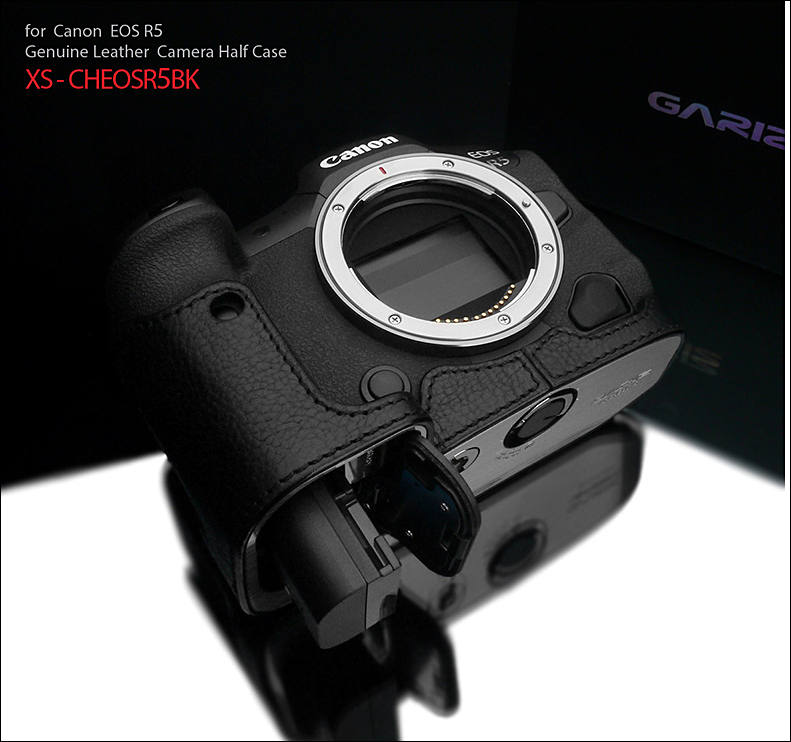
-
New round of thermal "tests"
With the lens on, and the camera sitting on a table, all covers closed and LCD folded against the camera back but not on we ran it for 18 minutes before getting a temp warning. The hottest part of the camera was the back behind the LCD door (43°C / 109°F), followed by the rear body around the command/set dials and the area of the grip where you rest your thumb (40°C / 104°F). The bottom plate around the tripod socket reached 38°C / 100°F.
At this point, we decided that the thermometers we were using were reading from a 1cm² area, which was kind of a blunt tool. So I got a little FLIR IR camera, spent some time checking it’s readings against both of the thermometers we used, and decided it was just as accurate and gave us a lot more information.
In case of R5 all this was big waste of time (it is waste of time for any camera until you measure how comfortable it is to hold it for people).
The chassis and shell of most cameras have been developed for years to be strong and light (most manufacturers use similar material). I’ve never thought they conducted heat well, but I didn’t know for sure.
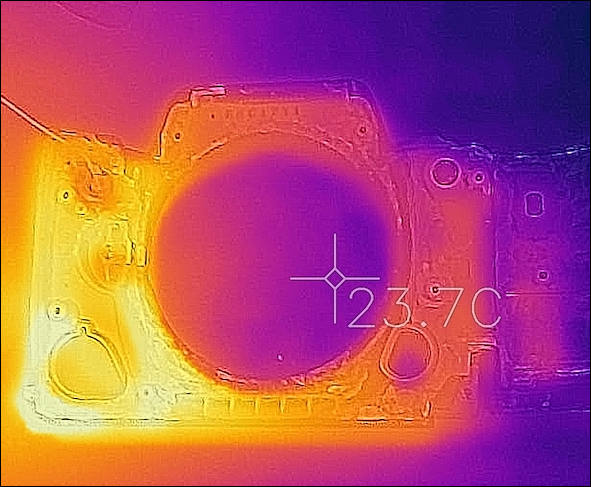
I used a narrow-gauge heat gun to heat the shell and see what happened.
Even students already started to cry here.
I overlaid an image from our teardown on the thermal image to show what’s right below there. Duh, the area over the processor and SDRAM cards.
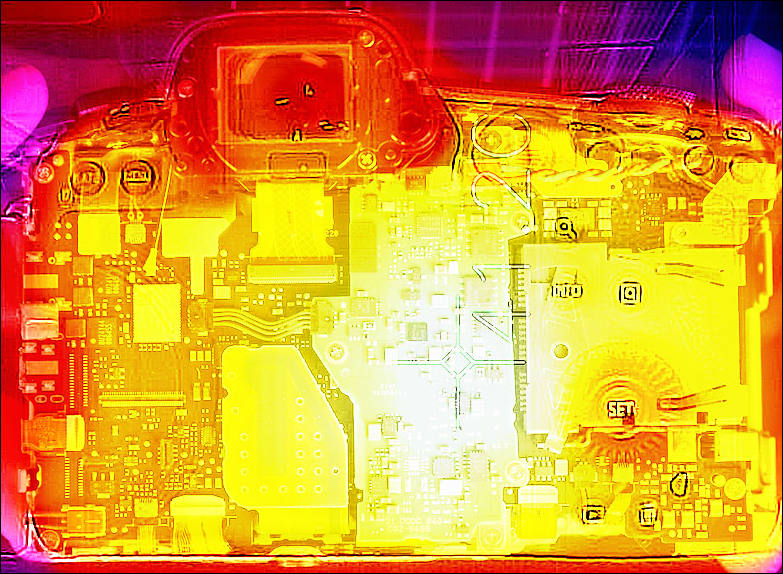
Who could have thought this? :-) And again - with back on here, it is just overlay!
It had been clear understanding between tech educated people that R5 issue is the processor area, its design and limits of LSI.
The bottom is my favorite in this group. Notice how every screw that goes into the metal tripod plate is lighting up. The lens mount ring is pretty hot, too, with a temp of 38°C.
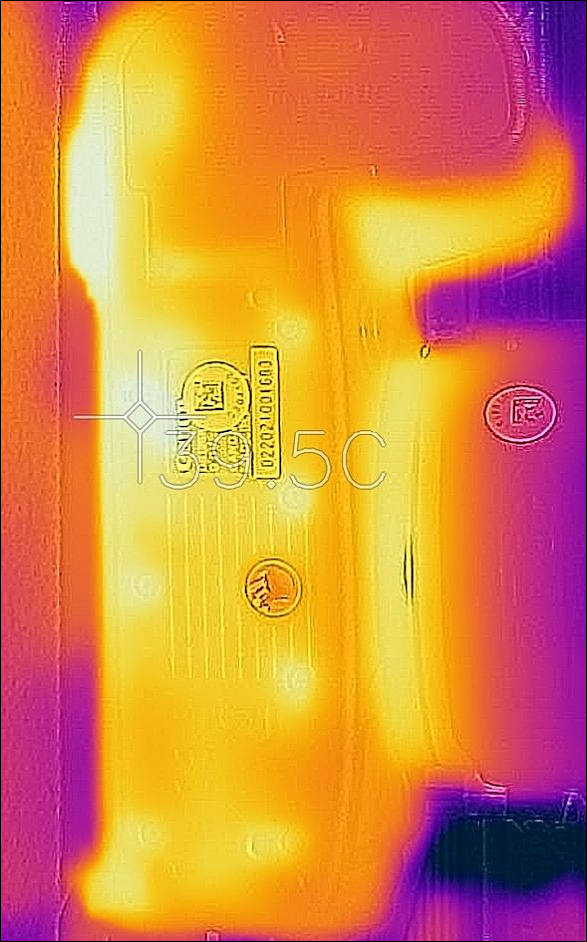
All it means that due to questionable cooling design it is only few of more or less exposed metal parts (read - only things that can transfer heat from inside to outside good).
And "new" firmware, Andrew says it is Canon playing with timers:
We got a longer run after upgrading to V1.1, getting 25 minutes before cut off, but at the expense of slightly higher temps.
To sensor
The sensor radiated quite a bit of heat, too. It wasn’t as hot as the card slot, but has a bigger surface area. It may also be that the metal in the IBIS unit is hot and that’s leaking out through the sensor area.
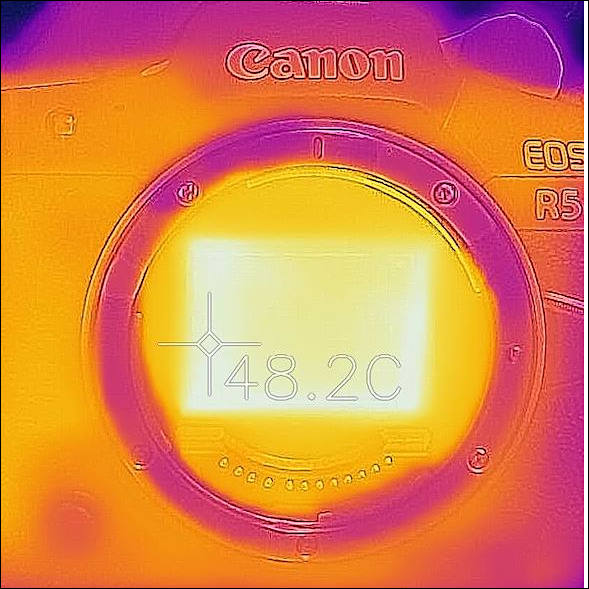
Here we have complex reflective surface that can affect measurement significantly (that authors did not understand), but overall IBIS sensors are very bad considering long time full sensor readout, as they have no way to dissipate the heat except the air around. Fixed sensor can be made much better cooled, it is also why companies always try to control how DR and noise are being measured in review for such cameras (as they are best if you do it in cool place and camera did not run before for long time).
https://wordpress.lensrentals.com/blog/2020/09/investigating-the-canon-r5-heat-emission/
So, all we have is mostly useless post made in non-systematic manner. Very sad.
Whole thing can be made due to this final words (as Lensrentals have innate interest to not have their R5 batch of the bodies suddenly devalue 2-3 times due to fixed new edition of camera):
Is Canon going to “fix this” as people keep saying? I doubt that’s possible, and I really doubt Canon thinks it needs fixing. I believe they consider it primarily a photography camera that can shoot some video. There may be another tweak or two, but I speculate that operating temps have to be kept at some level, and that cool down is always going to be slow. A firmware hack or update isn’t going to make the camera cool better; it’s going to allow it to work hotter. I think that probably isn’t a good idea.

 sa14540.jpg591 x 487 - 56K
sa14540.jpg591 x 487 - 56K
 sa14541.jpg783 x 574 - 150K
sa14541.jpg783 x 574 - 150K
 sa14542.jpg587 x 942 - 88K
sa14542.jpg587 x 942 - 88K
 sa14543.jpg589 x 589 - 66K
sa14543.jpg589 x 589 - 66K -
Here we go again
This means that all VRM chips, power circuitry, CPU, RAM, card, sensor – basically everything electronic – are within their comfort zones. If they were not, the camera would hang up or shut down, so that would be your first warning that the stress test has been failed and the real limits of the EOS R5 reached.
Andrew it DOES not mean this. It just means that damage happens quite slow, can be week, can be month, can be year, but it will show itself. And no, hanging up does not just happen automatically if you go out of specified limits
For example, badly thermally designed notebook can live 1-1.5 years of normal use, right to get pas warranty before it will start acting. Same is true, for example, considering Chinese TV set top boxes, many last for 2-6 months.
How severe damage can be? Extremely. Including BGA joins damage, transistors shortening, up to literal burned out holes in the big chips like camera LSI if VRM after short supplied high voltage to chip.
-
Gentle ping-pong
Johnnie: Both cameras suffered from overheating issues in video recording and more than that, long recovery times. By introducing the latest firmware update, it seems as if Canon is trying to overcome some of those issues by allowing longer recording and shorter recovery waiting times (until the camera can film again). What exactly is causing those cameras to overheat and what’s the new FW doing in order to help here?
Katsuyuki Nagai-san – Canon: I think we should look at the fundamentals of the whole topic to give a better perspective. The cameras feature cutting edge features squeezed into compact bodies designed to offer weather resistance.
This is where we come to the first of the two governing factors that affect the cameras when it comes to overheating. Holding a very warm object for an extended period has the potential to result in what is known as low temperature burns. Secondary is to protect the internal components of the camera from the overheating. We limit how hot the external body of the camera can get to protect users, which is one of the causes of overheat shutdown. Some heat management must also be applied to ensure the camera continues to operate.
-
Adorama is now showing an expected arrival date of October 20, 2020, for the Canon EOS R5.
Rumor is that new batch can come with different motherboard and some cooling changes.
-

 sa14693.jpg800 x 529 - 39K
sa14693.jpg800 x 529 - 39K -
Note that Canon PR and marketing is doing with thermal scandal - they try to bury it all under piles of useless info. They contacted lot of people lately and offered to publish as much texts and videos as possible (with their SEO help and special paid Google promotions).
-
Can we all just take a moment to agree that Canon is stupid? Like, really, really stupid? Like you could fix it stupid? Like with stuff from the 1980s?
-
I swapped out the thermal pads under the power sub-board (the green one) and added thermal pads between the power sub-board and the enclosure. So there’s another path for the heat from the CPU to the outside world (albeit somewhat indirect, CPU -> power sub-board -> enclosure).
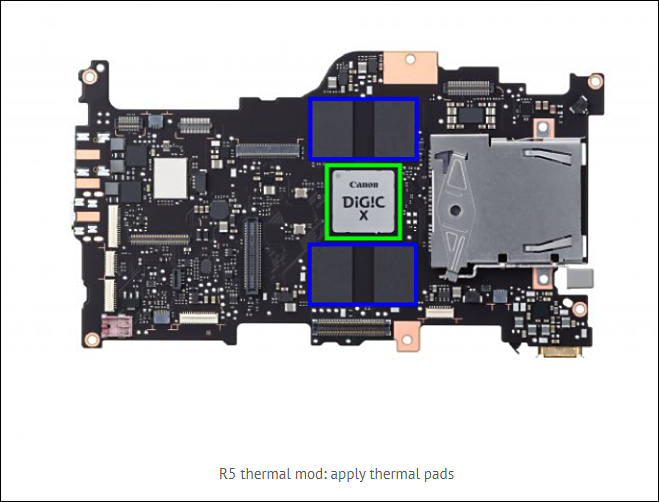
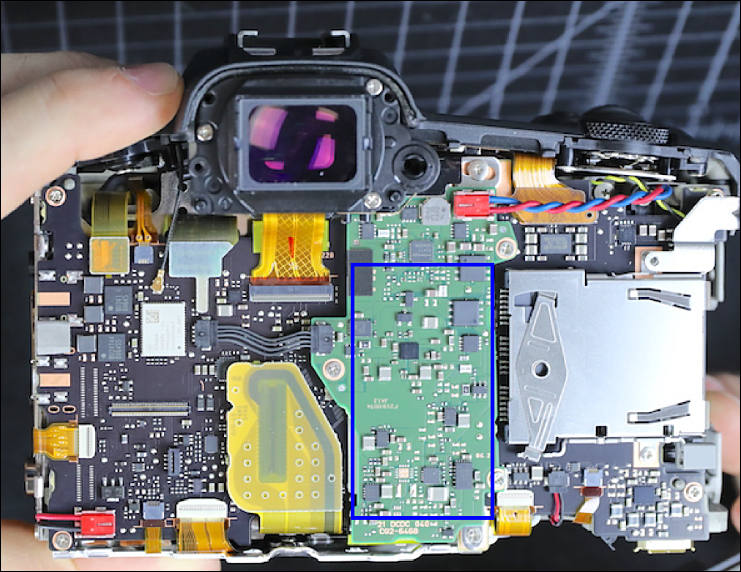
With room temperature (25C) it will still overheat in 8K. However sticking a fan next to it fixes it. :-)
https://blog.yifangu.com/2020/10/09/canon-eos-r5-thermal-mod/
So, as I told - it is one of the temperature sensors inside main LSI.

 sa15017.jpg659 x 502 - 46K
sa15017.jpg659 x 502 - 46K
 sa15018.jpg741 x 572 - 104K
sa15018.jpg741 x 572 - 104K -
Interesting, nice cheap and useful mod. This little green board position though :p I guess a redesigned copper heat sink(the aluminium one under the little green board) that will be bigger and get more contact points with the base plate and some well placed pads to connect to the rear plate would allow 8K for 1h with less time recovery.
-
V is right it is temp threshold plus timer
Is there room for an aluminum heat spreader? -
Canon EOS R5 firmware 1.2.0 incorporates the following fixes and features:
- When using high-speed or low-speed continuous shooting modes, in Drive Mode with [High Speed Display: OFF], the visibility of the subject within the frame has been improved when shooting moving objects (during continuous shooting black frames will be inserted between frames in the viewfinder and live view. This will improve the visibility of moving subjects in live view and in the viewfinder)
- Adds the [Auto] setting to the [Viewfinder brightness] menu that will brighten and dim based on ambient light conditions.
- Enables 2nd curtain shooting sync during radio transmission wireless flash shooting when the Speedlite EL-1 flash is attached to the camera.
- Enables manual flash output (excluding high-speed sync and optical transmission wireless flash shooting) to be selected and set up to 1/8192 from the camera menu screen when the Speedlite EL-1 flash is attached to the camera.
- Improves compatibility of HEIF images recorded in the camera with MIAF (Multi-Image Application Format) standards.
- Adds support for AF and release during zoom operations for some RF and EF lenses.
Howdy, Stranger!
It looks like you're new here. If you want to get involved, click one of these buttons!
Categories
- Topics List23,998
- Blog5,725
- General and News1,360
- Hacks and Patches1,153
- ↳ Top Settings33
- ↳ Beginners256
- ↳ Archives402
- ↳ Hacks News and Development56
- Cameras2,367
- ↳ Panasonic995
- ↳ Canon118
- ↳ Sony156
- ↳ Nikon96
- ↳ Pentax and Samsung70
- ↳ Olympus and Fujifilm101
- ↳ Compacts and Camcorders300
- ↳ Smartphones for video97
- ↳ Pro Video Cameras191
- ↳ BlackMagic and other raw cameras116
- Skill1,960
- ↳ Business and distribution66
- ↳ Preparation, scripts and legal38
- ↳ Art149
- ↳ Import, Convert, Exporting291
- ↳ Editors191
- ↳ Effects and stunts115
- ↳ Color grading197
- ↳ Sound and Music280
- ↳ Lighting96
- ↳ Software and storage tips266
- Gear5,420
- ↳ Filters, Adapters, Matte boxes344
- ↳ Lenses1,582
- ↳ Follow focus and gears93
- ↳ Sound499
- ↳ Lighting gear314
- ↳ Camera movement230
- ↳ Gimbals and copters302
- ↳ Rigs and related stuff273
- ↳ Power solutions83
- ↳ Monitors and viewfinders340
- ↳ Tripods and fluid heads139
- ↳ Storage286
- ↳ Computers and studio gear560
- ↳ VR and 3D248
- Showcase1,859
- Marketplace2,834
- Offtopic1,320




